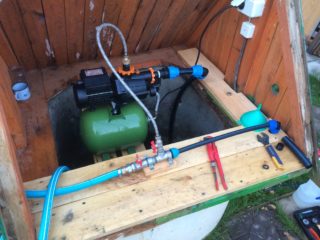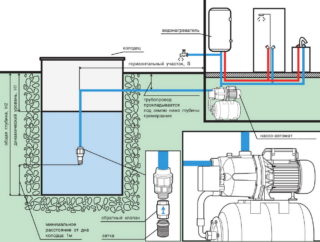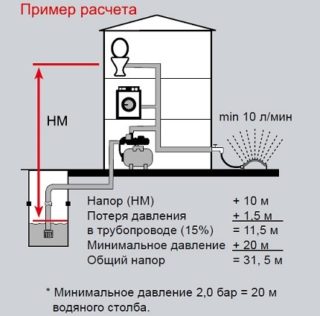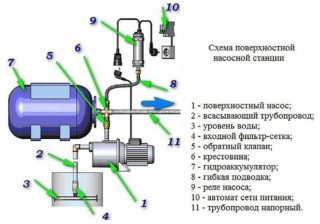Pumping stations are equipment designed to lift water from the depth of wells and wells. If a private house is connected to a central water main, they are used to maintain the required pressure of the water flow. Unlike submersible pumps, they maintain a constant pressure in the pipeline. In order for the water supply to work around the clock without interruption, it is important to correctly install a pumping station to supply water to a private house.
Pumping station device
The station diagram includes the following nodes:
- centrifugal pump that lifts and transports water;
- hydraulic accumulator that softens water hammer;
- water intake system with a check valve;
- pressure gauge to determine the degree of pressure;
- pressure switch for its control;
- Electrical engine.
Previously, instead of a hydraulic accumulator, storage tanks were used, but now such devices are practically not used.
Installation rules

The connection diagram of a pumping station in a private house (piping) depends on the location of the installation, as well as on the level of freezing of the ground.
Choosing a place to install the device
The first thing that needs to be done is to determine the location of the pumping station. This could be:
- indoor premises (basement, underground);
- caisson - an insulated and waterproofed pit located below the level of soil freezing;
- shelf in the well.
When choosing, you should be guided by technical indicators - the maximum suction depth of the pump. In the wells, only the arrangement of the caisson is possible, since the station can only raise water from a depth of 9 meters. A disguised pit will also be required in the country - with an outdoor arrangement, the device can simply be stolen. You can also mount it on a shelf in a summer cottage well, but for safety, you need a steel cover that can be locked with a reliable lock.
It is safest to install a water supply station in the utility room of a private house. The downside of this installation is the noise from its work. To reduce the sound level, the device is installed on thick rubber, but this will not give complete sound insulation.
Connection diagram

For the uninterrupted operation of the station, it will be necessary to ensure a continuous supply of water from the source. When using the system water supply all year round, you will need to worry about freezing protection. To do this, a straight ditch is dug from a well or a caisson to the foundation of the house, into which pipes will then be laid.
It is necessary to bury pipe sections below the depth to which the soil freezes. When forming a trench, it will be necessary to take into account the slope towards the water intake so that excess water is drained from the pipeline during the conservation period.
In a situation with a close location of subsurface sources, pipes are installed above their critical level. The main line must be insulated or a heating cable must be used.
The electric motor of the pump has a high power, therefore it is better to allocate a separate power supply line for the entire installation, make grounding, and also install a voltage stabilizer.
The piping of the pumping station in a private house is performed in the following order:
- A water intake unit is mounted.To do this, connect a metal mesh filter and a check valve to the outside of the polypropylene pipe. The latter is necessary for the stable filling of the pipeline with water. Its fixation is carried out by means of a coupling with an external thread.
- The hydraulic accumulator and the control unit are installed. It is best to connect them by means of a five-way union, mounted in the pressure pipeline in a convenient place. Also, a pressure gauge and a pressure switch are installed on it, and a hydraulic accumulator is connected to the side entry of the fitting.
- Consumers are connected to the pumping unit, first - the distributing manifold.
- Before starting, the working part of the system is filled with water. To do this, unscrew the plug from the filler hole located at the top of the pump, or use a special funnel. Then the plug is installed in place.
- Connect to the power supply for soft start and check the pressure and automation. At first, the water will go with air - air locks formed when filling the pumping station are removed. A smooth stream without bubbles is an indicator that the system has switched to operating mode, you can use it.
After starting the station, water should flow from the outlet of the pressure pipeline or an open water tap for two to three minutes. If this does not happen, the installation is turned off and water is added to the system, and then it is restarted. When the start-up of the equipment has been successfully completed, it is necessary to "run in" it, and then adjust the settings of the pressure switch and the hydraulic unit.
When installing the surface parts of the device, take into account that all additional devices are best installed using check valves or ball valves with an American. This is necessary for easy removal of the device for replacement or repair work, without the need to drain the water from the pipeline.
It is best to provide for the possibility of draining water from the system in advance. To do this, a branch is created in the pipeline by installing a tee with a drain valve connected to it.
Common installation errors

If you have filled in water, and the installation does not work out in any way - the water does not come in or comes in jerks - you need to figure it out. There are several probable reasons:
- There is no check valve on the suction pipe placed in the source, or it does not work.
- Somewhere on the pipe there is a leaky joint, through which air is sucked in.
- The productivity of the station does not correspond to the amount of water consumed.
- The resistance of the pipeline is too high - a pipe with a large cross-section or with smoother walls is needed.
- The water mirror is too low.
- Not enough pump power.
Frequent shutdowns and shutdowns occur as a result of improper installation of the hydraulic tank. The electric motor of the pumping equipment may break down due to power outages, a backup power supply can solve this problem. With frequent power surges, circuit breakers and stabilizers are needed.
To check the equipment for damage, test it by placing a short supply line in a container of water. If everything works, check the line, the suction depth and the non-return valve.
After connection, the pumping station needs a systematic examination. It is necessary to constantly check the condition of the coarse filter and, if necessary, wash it. If this is not done, the productivity of the station will decrease, and the water will flow in jerks. If the filter is completely clogged, the pump will run in idle mode and the station will shut down. How often the filter element needs to be cleaned depends on the amount of impurities in the water.









